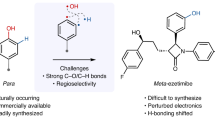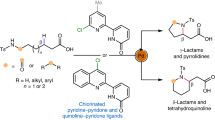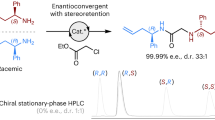Abstract
The formation of carbon–carbon bonds is a fundamental transformation in organic synthesis. In spite of the myriad methods available, advantageous methodologies in terms of selectivity, availability of starting materials, operational simplicity, functional-group tolerance, environmental sustainability and economy are in constant demand. In this context, the development of new cross-coupling reactions that use catalysts based on inexpensive and non-toxic metals is attracting increasing attention. Similarly, efficient processes that do not require a metal catalyst are of extraordinary interest. Here, we report a new and efficient metal-free carbon–carbon bond-forming coupling between tosylhydrazones and boronic acids. This reaction is very general and functional-group tolerant. As the required tosylhydrazones are easily generated from carbonyl compounds, it can be seen as a reductive coupling of carbonyls, a process of high synthetic relevance that requires several steps using other methodologies.
This is a preview of subscription content, access via your institution
Access options
Subscribe to this journal
Receive 12 print issues and online access
$259.00 per year
only $21.58 per issue
Buy this article
- Purchase on Springer Link
- Instant access to full article PDF
Prices may be subject to local taxes which are calculated during checkout



Similar content being viewed by others
References
de Mejiere, A. & Diederich, F. Metal-Catalyzed Cross-Coupling Reactions (Wiley-VCH, 2004).
Sheldon, R., Arends, I. & Hanefeld, U. Green Chemistry and Catalysis (Wiley-VCH, 2007).
Czaplik, W. M., Mayer, M. & von Wangelin, A. J. Domino iron catalysis: direct aryl–alkyl cross-coupling. Angew. Chem. Int. Ed. 48, 607–610 (2009).
Kolb, H. C., Finn, M. G. & Sharpless, K. B. Click chemistry: diverse chemical function from a few good reactions. Angew. Chem. Int. Ed. 40, 2004–2021 (2001).
Moorhouse, A. D. & Moses, J. E. Click chemistry and medicinal chemistry: a case of ‘cyclo-addition’. ChemMedChem. 3, 715–723 (2008).
Medal, M. Polymer ‘clicking’ by CuAAC reactions. Macromol. Rapid Commun. 29, 1016–1051 (2008).
Kele, P., Mezo, G., Achatz, D. & Wolfdeis, O. S. Dual labeling of biomolecules by using click chemistry: a sequential approach. Angew. Chem. Int. Ed. 48, 344–347 (2009).
Fulton, J. R., Aggarwal, V. K. & de Vicente, J. The use of tosylhydrazone salts as a safe alternative for handling diazo compounds and their applications in organic synthesis. Eur. J. Org. Chem. 1479–1492 (2005).
Aggarwal, V. K., de Vicente, J. & Bonnert, R. V. Catalytic cyclopropanation of alkenes using diazo compounds generated in situ. A novel route to 2-arylcyclopropylamines. Org. Lett. 3, 2785–2788 (2001).
Aggarwal, V. K., Alonso, E., Hynd, G., Lydon, K. M., Palmer, M. J., Porcelloni, M. & Studley, J. R. Catalytic asymmetric synthesis of epoxides from aldehydes using sulfur ylides with in situ generation of diazocompounds. Angew. Chem. Int. Ed. 40, 1430–1433 (2001).
Aggarwal, V. K., Alonso, E., Fang, G., Ferrara, M., Hynd, G. & Porcelloni, M. Application of chiral sulfides to catalytic asymmetric aziridination and cyclopropanation with in situ generation of the diazo compound. Angew. Chem. Int. Ed. 40, 1433–1436 (2001).
Cheung, W.-H., Zheng, S.-L. Yu, W.-Y., Guo-Chuan Zhou, G.-C. & Che, C.-M. Ruthenium porphyrin catalyzed intramolecular carbenoid C-H insertion. Stereoselective synthesis of cis-disubstituted oxygen and nitrogen heterocycles. Org. Lett. 5, 2535–2538 (2003).
Barluenga, J., Moriel, P., Valdés, C. & Aznar, F. N-Tosylhydrazones as reagents for cross-coupling reactions: a route to polysubstituted olefins. Angew. Chem. Int. Ed. 46, 5587–5590 (2007).
Vedejs, E. & Stolle, W. T. Reductive alkylation of aldehyde tosylhydrazones with organolithium reagents. Tetrahedron Lett. 18, 135–138 (1977).
Myers, A. G. & Movassaghi, M. Highly efficient methodology for the reductive coupling of aldehyde tosylhydrazones with alkyllithium reagents. J. Am. Chem. Soc. 120, 8891–8892 (1998).
Hall, G. D. Boronic Acids: Preparation and Applications in Organic Synthesis and Medicine (Wiley-VCH, 2004).
Bamford, W. R. & Stevens, T. S. The decomposition of toluene-p-sulfonylhydrazones by alkali. J. Chem. Soc. 4735–4740 (1952).
Cuevas-Yañez, E., Serrano, J. M., Huerta, G., Muchowsky, J. M. & Cruz-Almanza, R. Copper carbenoid mediated N-alkylation of imidazoles and its use in a novel synthesis of bifonazole. Tetrahedron 60, 9391–9396 (2004).
Juteau, H. et al. Structure–activity relationship on the human EP3 prostanoid receptor by use of solid support chemistry. Bioorg. Med. Chem. Lett. 11, 747–749 (2001).
Kitbunnadaj, R. et al. Identification of 4-(1H-imidazol-4(5)-ylmethyl)pyridine (Immethridine) as a novel, potent, and highly selective Histamine H3 receptor agonist. J. Med. Chem. 47, 2414–2417 (2004).
Long, Y.-Q. et al. Rational design and synthesis of novel dimeric diketoacid-containing inhibitors of HIV-1 Integrase: implication for binding to two metal ions on the active site of integrase. J. Med. Chem. 47, 2561–2573 (2004).
Forsch, R. A., Queener, S. F. & Rosowsky, A. Preliminary in vitro studies on two potent, water-soluble trimethoprim analogues with exceptional species selectivity against dihydrofolate reductase from Pneumocystis carinii and Mycobacterium avium. Bioorg. Med. Chem. Lett. 14, 1811–1815 (2004).
Panda, G. et al. Effect of substituents on diarylmethanes for antitubercular activity. Eur. J. Med. Chem. 42, 410–419 (2007).
Molander, G. A. & Elia, M. D. Suzuki–Miyaura cross-coupling reactions of benzyl halides with potassium aryltrifluoroborates. J. Org. Chem. 71, 9198–9202 (2006).
Burns, M. J., Fairlamb, I. J. S., Kapdi, A. R., Sehnal, P. & Taylor, R. J. K. Simple palladium(ii) precatalyst for Suzuki-Miyaura couplings: efficient reactions of benzylic, aryl, heteroaryl, and vinyl coupling partners. Org. Lett. 9, 5397–5400 (2007).
Henry, N., Enguehard-Gueiffier, C., Thery, I. & Gueiffier, A. One-pot dual substitutions of bromobenzyl chloride, 2-chloromethyl-6-halogenoimidazo[1, 2-a]pyridine and -[1, 2-b]pyridazine by Suzuki-Miyaura cross-coupling reactions. Eur. J. Org. Chem. 4824–4827 (2008).
Vanier, C., Lorgé, F., Wagner, A. & Mioskowski, C. Traceless solid-phase synthesis of biarylmethane structures through Pd-catalyzed release of benzylsulfonium salts. Angew. Chem. Int. Ed. 39, 1679–1682 (2000).
Chupak, L. S., Wolkowsky, J. P. & Chantigny, Y. A. Palladium-catalyzed cross-coupling reactions of benzyl indium reagents with aryl iodides. J. Org. Chem. 74, 1388–1390 (2009).
Bedford, R. B., Huwe, M. & Wilkinson, M. C. Iron-catalysed Negishi coupling of benzyl halides and phosphates. Chem. Commun. 600–602 (2009).
Hooz, J. & Linke, S. The reaction of trialkylboranes with diazoacetone. A new ketone synthesis. J. Am. Chem. Soc. 90, 5936–5937 (1968).
Brown, H. C., Midland, M. M. & Levy A. B. Reaction of dialkylchloroboranes with ethyl diazoacetate at low temperatures. Facile two-carbon homologation under exceptionally mild conditions. J. Am. Chem. Soc. 94, 3662–3664 (1972).
Zang, Z. & Wang, J. Recent studies on the reactions of α-diazocarbonyl compounds. Tetrahedron, 64, 6577–6605 (2008).
Peng, C., Wang, Y. & Wang, J. Palladium-catalyzed cross-coupling of α-diazocarbonyl compounds with arylboronic acids. J. Am. Chem. Soc. 130, 1566–1567 (2008).
Peng, C., Zhang, W., Yan, G. & and Wang, J. Arylation and vinylation of α-diazocarbonyl compounds with boroxines. Org. Lett. 11, 1667–1670 (2009).
Brown, H. C., Jadhav, P. K. & Bhat, K. S. An asymmetric synthesis of the diastereomeric 1-(2-cyclohexenyl)-1-alkanols in high optical purity via a stereochemically stable allylic borane, B-2-cyclohexen-1-yldiisopinocampheylborane. J. Am. Chem. Soc. 107, 2564–2565 (1985).
Fang, G. Y. & Aggarwal, V. K. Asymmetric synthesis of α-substituted allyl boranes and their application in the synthesis of iso-agatharesinol. Angew. Chem. Int. Ed. 46, 359–362 (2007).
Acknowledgements
This work was funded by Ministerio de Ciencia of Spain (CTQ2007-61048/BQU) and Consejería de Educación y Ciencia of Principado de Asturias (IB08-088). A FPU from predoctoral fellowship Ministerio Ciencia e Innovación of Spain to M.T.-G. is gratefully acknowledged.
Author information
Authors and Affiliations
Contributions
M.T.-G. carried out the experimental work. All authors analysed the data, discussed the results and commented on the manuscript.
Corresponding authors
Supplementary information
Supplementary information
Supplementary information (PDF 1792 kb)
Rights and permissions
About this article
Cite this article
Barluenga, J., Tomás-Gamasa, M., Aznar, F. et al. Metal-free carbon–carbon bond-forming reductive coupling between boronic acids and tosylhydrazones. Nature Chem 1, 494–499 (2009). https://doi.org/10.1038/nchem.328
Received:
Accepted:
Published:
Issue Date:
DOI: https://doi.org/10.1038/nchem.328
This article is cited by
-
A practical preparation of bicyclic boronates via metal-free heteroatom-directed alkenyl sp2-C‒H borylation
Communications Chemistry (2023)
-
Building bridges
Nature Chemistry (2021)
-
An intramolecular coupling approach to alkyl bioisosteres for the synthesis of multisubstituted bicycloalkyl boronates
Nature Chemistry (2021)
-
Passerini-type reaction of boronic acids enables α-hydroxyketones synthesis
Nature Communications (2021)
-
Palladium-catalyzed Suzuki-Miyaura coupling of thioureas or thioamides
Nature Communications (2019)



